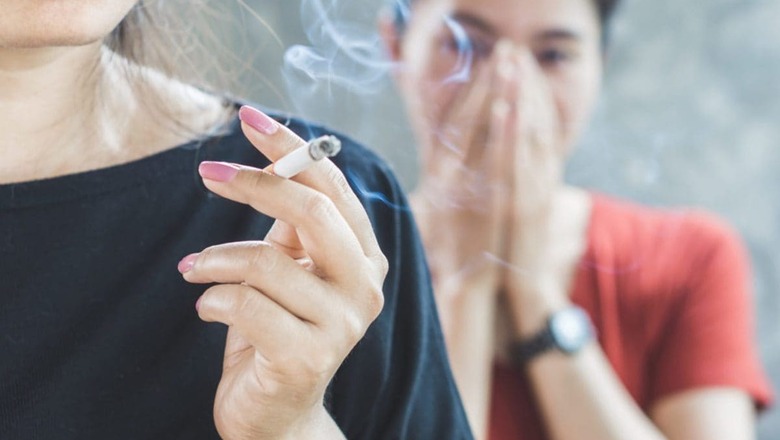
views
We all know the harmful effects of tobacco use on the human body. While we are aware of the risks associated with first-hand smoke, there has been an increased recognition on the risks caused by second & third-hand smoke. The non-smokers who are exposed to this type of smoke also face significant dangers to their well-being. Second-hand smoke, also known as environmental tobacco smoke (ETS), combines the smoke exhaled by smokers and the smoke emitted from burning tobacco products (side stream smoke), whereas third-hand smoke forms when the particles from a cigarette or any other tobacco-burning device gets absorbed into materials like hair, furniture, carpet, clothes, and walls. The second & third-hand smokes contain over 7,000 chemicals, including at least 70 known to cause cancer. Non-smokers who live with smokers are at increased risk of smoking-related illnesses and by thus, the risk of coronary heart disease increases by 25%–30% and lung cancer by 20%–30%.
Hazards of Second & Third-hand Smoke on Children
- Respiratory Issues:Children exposed to second & third-hand smoke are at an increased risk of developing respiratory issues such as asthma, bronchitis, and pneumonia. The chemicals present in these types of smoke can also cause genetic mutations and abnormal cell growth leading to the development of lymphoma, a tumor that occurs in the lymphatic system.
- Leukaemia:It is a type of cancer that affects the blood and bone marrow, it can be considered as a side effect on children who are exposed to second & third-hand smoke. The chemicals can disrupt the normal functioning of cells and can damage the DNA within blood cells, leading to abnormal growth of cells and the development of leukaemia.
- Sudden Infant Death Syndrome (SIDS):Infants exposed to second & third-hand smoke inhale toxic chemicals that can affect their developing respiratory and cardiovascular systems, which makes them more sensitive to SIDS.The inhaled chemicals can disrupt the infant’s regular breathing and heart rate, leading to unexplained and unexpected death.
- Brain Tumor:When children are exposed to numerous carcinogens present in second & third-hand smoke, it can cause devastating effects on their bodies as their immune systems are still developing. The Harmful chemicals from the smoke, like benzene, formaldehyde, and polycyclic aromatic hydrocarbons, can trigger the growth of tumors in the brain, hence it is crucial to create smoke-free environments and create awareness about the side effects of second & third-hand smoke.
Hazards of Second & Third-hand Smoke on Adults
- Stroke/Cardiovascular Diseases:Adults exposed to second & third hand smoke tend to inhale toxic chemicals that enter their bloodstream and cause harmful effects on their cardiovascular system leading to stroke and other cardiovascular diseases. These toxic particles can lead to inflammation and damage the blood cells, leading to atherosclerosis, a condition where the arteries become hard and narrow. This condition can interrupt the blood flow and increase the chances of stroke.
- Impaired Liver Function:The harmful chemicals present in second & third-hand smoke can affect the liver function in the human body. The liver plays a significant role in filtering out toxins from the human body. Still, constant exposure to the toxic chemicals from second & third-hand smoke can lead to liver damage, inflammation, and oxidative stress.
- Cancer:The presence of carcinogens in second & third-hand smoke puts non-smokers at a higher risk of developing various types of cancer, including lung, throat, and breast cancer. Long-term exposure to these toxic substances can build cancer cells by damaging the DNA within lung cells and other body parts.
- Allergies:Some people may suffer from allergic reactions when exposed to second & third-hand smoke residue. It can trigger itching, sneezing, skin rashes and watery eyes in sensitive individuals.
Protecting Non-Smokers
Non-smokers need to be protected from second & third-hand smoke exposure within the home, at school and in the workplace. Here are some ways to promote protection:
- Smoke-Free Legislation:Enact and enforce comprehensive smoke-free legislation to protect non-smokers from the hazards of second & third-hand smoke. These laws should include restrictions on smoking in public places, workplaces, and homes where non-smokers reside.
- Public Awareness Campaigns:Educating the public about the dangers of second & third-hand smoke is crucial. Awareness campaigns can help individuals understand the risks they face and encourage smokers to be considerate of non-smokers by refraining from smoking in their presence.
- Promoting Smoke-Free Environments:Businesses, organizations, and institutions should establish smoke-free policies prohibiting smoking. This includes restaurants, bars, hotels, parks, and recreational areas. Encouraging smoke-free environments protects non-smokers and supports those who wish to quit smoking.
- Designated Smoking Areas:In cases where complete smoking bans are not feasible, creating well-ventilated designated smoking areas can help minimize the exposure of non-smokers to second & third-hand smoke. These areas should be isolated, away from entrances and windows, and equipped with proper ventilation systems.
- Support for Smoking Cessation:Encouraging smokers to quit is essential for safeguarding non-smokers from the harmful effects of second & third-hand smoke. Smokers should be provided with accessible and affordable smoking cessation programs and resources to help individuals quit smoking successfully.
Second & third-hand smoke poses a significant threat to non-smokers, leading to various health issues, including respiratory problems, cardiovascular diseases, allergies, liver damages and cancer. It is important to remember that there is no safe exposure to second & third-hand smoke. Hence, people need to be better informed of the hazards of second & third-hand smoke to themselves, foetuses, children, and other family members.
















Comments
0 comment